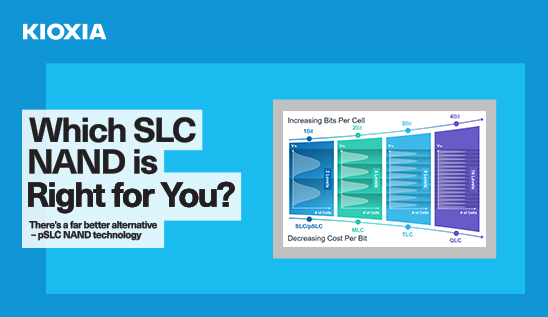
Noted for its high performance, reliability, compact form factor, low power consumption, and ability to work over an extended temperature range, single-level cell (SLC) NAND is a cornerstone NAND flash technology. Given its multiple positive attributes, it's no surprise that SLC NAND can be found in a variety of applications needing long life and/or high reliability, including IoT, automotive and emerging embedded applications.
SLC NAND offers an excellent balance between cost and performance to store boot and small to medium OS code for many applications. Yet, for high-density storage applications it presents a major drawback: cost. In fact, the technology can often be prohibitively expensive.
Until recently, designers faced a serious dilemma. One could take a cautious approach and turn to durable, yet expensive, SLC NAND, or opt for a lower cost, yet also less reliable and slower performing, multi-level cell (MLC) and triple-level cell (TLC) NAND. Today, however, there's a far better alternative - pseudo-SLC (pSLC) NAND technology.
A few questions consistently come to mind when deciding which type of SLC NAND to use in a given application – and I’m addressing them here:
Q: How does pSLC work?
A: pSLC NAND operates in a manner similar to SLC NAND by programming only one bit in each memory cell in MLC, TLC, or QLC devices. MLC, TLC, and QLC are less expensive memory devices than SLC. By operating in a pSLC mode, the amount of total memory storage is sacrificed for the benefit of having greater program erase cycle endurance. Thus, pSLC provides a cost-effective alternative to SLC NAND. pSLC up to this point has been used in floating gate technology and is also particularly attractive because it can be used in the latest 3D technology.
Q: Why is one the magic number?
A: Reducing the number of stored bits in each cell to only one increases the NAND's lifespan and reliability while lowering cost - a win-win proposition.
Q: What other advantages does pSLC bring to the table over SLC?
A: Although pSLC NAND technology shrinks MLC NAND memory capacity by 50%, TLC capacity by 66.6%, and QLC NAND capacity by 75%, it still manages to deliver a significantly lower cost-per-bit than pure SLC NAND, thanks to its higher cell density. Best of all, pSLC NAND boosts reliability, performance, and endurance attributes to levels closely comparable to costlier SLC NAND technology.
Q: What are some key factors that would sway a designer away from SLC and toward pSLC?
A: Lower cost is usually the primary reason for turning to pSLC NAND. While pSLC NAND adopters are never going to achieve the high reliability of pure SLC NAND, there's a price reliability/balance, or tradeoff, that always comes into play.
Q: Who should be considering pSLC for their designs?
A: pSLC NAND is an excellent solution for any medium to high density storage application that demands high reliability, durability and the ability to completely maintain and protect code and data integrity. Overall, pSLC NAND is a good fit for applications that require SLC NAND level endurance, but that can't tolerate the high-cost burden pure SLC NAND demands.
Q: Where does this technology really shine?
A: SLC and pSLC really prove their value when deployed in devices and systems that routinely experience extreme environmental conditions. This includes cell tower equipment, outdoor signage, industrial sites, outside IoT devices, trucks, and trailers. Anything that's likely to experience extreme internal and external temperature conditions.
Specific pSLC NAND applications include network cards and small SSDs. In fact, any application that must reliably function in an environment with extreme high or low temperatures can benefit from pSLC NAND technology.
Q: Does pure SLC NAND still have a role to play in the market?
A: Yes, absolutely. It's important to remember that while pSLC NAND has arrived as a breakthrough storage technology, it will never completely eliminate the need for pure SLC NAND devices. Application, performance and reliability requirements will always stand as the benchmarks that ultimately determine which SLC NAND solution should be used.
Disclaimer
The views and opinions expressed in this blog are those of the author(s) and do not necessarily reflect those of KIOXIA America, Inc.